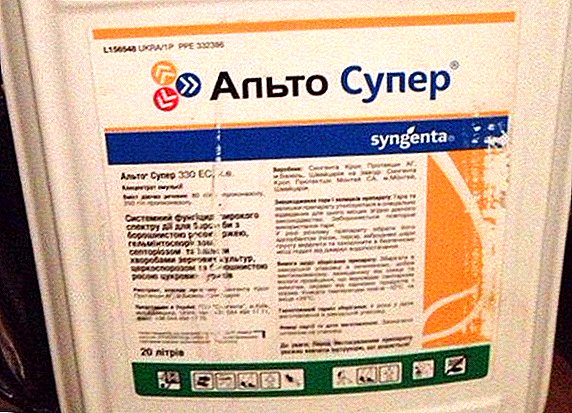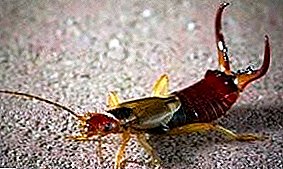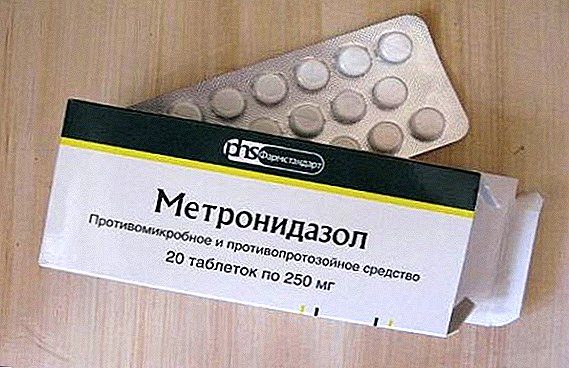 The expression "chickens in the fall is considered" was not a feat. Nestlings of chickens and other agricultural birds are much more than adults, are subject to a variety of diseases, because their immunity is still too weak to withstand external threats. The most effective and reliable way to protect against bacteria, as you know, are antibiotics. One of these drugs, which is often used in the treatment of poultry, is Metronidazole. Consider the features of its use in the article.
The expression "chickens in the fall is considered" was not a feat. Nestlings of chickens and other agricultural birds are much more than adults, are subject to a variety of diseases, because their immunity is still too weak to withstand external threats. The most effective and reliable way to protect against bacteria, as you know, are antibiotics. One of these drugs, which is often used in the treatment of poultry, is Metronidazole. Consider the features of its use in the article.
Release form
"Metronidazole" is not a drug with a narrow focus. Since 1960, its antibacterial and antiparasitic activity has been successfully used to treat people and animals (not only birds), and therefore the medicine is available in various forms, in particular, in the form of:
- tablets;
- granulate;
- powders;
- injection solutions;
- cream for external use;
- vaginal suppositories;
- balls.
In veterinary medicine, tablets or granules are mainly used, less commonly solutions for injections.
Tablets "Metronidazole" have the form of a flat cylinder of white or yellow-green color with softened sharp corners between the side and the base (the so-called chamfer) and one perpendicular notch, allowing the pill to be divided in half.  The weight of the tablet and the content of the active substance in it may be different, namely:
The weight of the tablet and the content of the active substance in it may be different, namely:
- 0.25 g, containing 0.0625 g, or 25% antibiotic;
- 0.5 g, containing 0.125 g, or 25% antibiotic;
- 0.5 g, containing 0.25 g, or 50% antibiotic;
- 1 g containing 0.25 g, or 25% of the antibiotic.
In addition to the "Metronidazole" tablet contains excipients - potato starch, octadecanoic acid and talkohlorit.
Pharmacological properties
The drug belongs to the drugs with antibacterial and antiparasitic effect, effective against many microbes and other parasites. In particular, sensitivity to the antibiotic is shown by:
- trichomonas;
- lamblia;
- histomonad;
- amoeba;
- balantidia.
Did you know? Balantidia (the word "balantidium" in Greek means "bag") is the largest single-cell parasite dangerous to humans, affecting colon tissue and is the causative agent of infusorial dysentery. According to some data, from 4 to 5% of the rural population are carriers of this ciliate and most often the infection comes from contact with pigs, although the disease is sometimes even found in dogs.
Microbes with enzyme systems that can restore the nitro group and accelerate the process of interaction of ferredoxin proteins with nitrogenous compounds fall into the field of action of the drug. The antibiotic suppresses the formation of sensitive DNA cells by reducing the nitro group (NO2), whose products destroy the DNA of microorganisms, preventing its resumption and synthesis. Such a mechanism of action makes the drug effective in the fight against microorganisms that can live and develop in the absence of atmospheric air (anaerobic forms of bacteria), but the medicine is powerless against aerobes and fungi.  The positive aspects of the drug should be attributed to its high efficacy in oral use. The active substance from the digestive tract is very rapidly absorbed into the blood and spreads to all organs and tissues, accumulating in the liver.
The positive aspects of the drug should be attributed to its high efficacy in oral use. The active substance from the digestive tract is very rapidly absorbed into the blood and spreads to all organs and tissues, accumulating in the liver.
One of the common problems are parasites in chickens. Therefore, the owners of these poultry should know how to get rid of chicken worms, peroedov, lice and ticks.
Removal of the drug occurs with urine and feces, painting them in a characteristic red-brown color. Fully drug is removed after 48 hours after the last dose.
What diseases are used for?
"Metronidazole" is used to treat a variety of bacterial infections and parasitic diseases, but for the poultry there are only three indications for this use:
- Trichomoniasis - diphtheritic and ulcerative lesions of the upper digestive tract and other organs caused by protozoa of the genus Trichomonas.
- Coccidiosis - Invasive disease, especially often affecting youngsters, pathogen - unicellular Coccidia squad.
- Histomoniasis (also known as enterohepatitis, or tifiohepatitis, popularly also known as "black head") is an infectious disease, also particularly dangerous for chickens, caused by the protozoans from the family Histomonas mellagridis.
Dosage
Since the drug is used to treat various types of animals for various diseases, it is possible to speak in detail about the dosage only in relation to each specific case.
Important! The norms of the drug intake, the dose and the period of treatment depend on the purpose of the treatment (treatment or prophylaxis), the nature of the disease, the type of animal, and its age. As with any other antibiotics, strict adherence to these rules in relation to "Metronidazole" is mandatory.However, in general, the medicine is usually dosed at the rate of 20 mg of the active substance per each kilogram of the animal’s mass per day, with oral administration 2 times a day, 10 mg.
Application for birds
Each type of poultry has its own peculiarities when using Metronidazole.
Broiler chickens
Broiler chickens are particularly sensitive to parasites such as Coccidia and Histomonas mellagridis. These protozoa can hit the chicks literally in the first days of their lives, so if you do not take timely and emergency measures, you can lose all the young livestock that will die without having managed to gain the proper weight.  "Metronidazole" allows you to solve this problem at a very early stage, even before the disease will be felt. For this reason, despite the fact that, as is well known, taking antibiotics for preventive purposes is a bad practice, they still resort to it in poultry farming, giving the chickens the drug four times, 20–25 mg per 1 kg of live weight in the first days of life and then every two weeks until the bird reaches the age of six months.
"Metronidazole" allows you to solve this problem at a very early stage, even before the disease will be felt. For this reason, despite the fact that, as is well known, taking antibiotics for preventive purposes is a bad practice, they still resort to it in poultry farming, giving the chickens the drug four times, 20–25 mg per 1 kg of live weight in the first days of life and then every two weeks until the bird reaches the age of six months.
Important! The drug is poorly soluble in water, so you need to add it to food (which, of course, is not very convenient, because the sick bird often refuses to eat, but it constantly experiences thirst). The tablet is ground to powder and thoroughly mixed with food.
However, if the chicks have the first signs of coccidiosis, histomoniasis or trichomoniasis, the treatment regimen should look different. In this case, the drug is prescribed in the same daily dosage, but given for 2-5 days, after which the course is repeated after 8 days.
Symptoms of diseases against which Metronidazole is effective are bloody diarrhea, decreased activity, lack of appetite, dishevel, knocking into heaps, increased thirst, paralysis.
Like any antibiotic, Metronidazole should be taken regularly, avoiding violation of the timing of the introduction of the next dose, because it can not only reduce the therapeutic effect, but also lead to the formation of drug-resistant parasite strains. If the reception of the funds was nevertheless forced to be interrupted, it is necessary to resume treatment as soon as possible according to a pre-established scheme.
We recommend to learn about common infectious and non-infectious diseases of broiler chickens.
Turkey poults
 For the poults of the diseases listed above, the most characteristic is histology, which affects the liver of young birds and often leads to their death. Usually, the first signs of illness (yellow diarrhea with foam, loss of appetite and mobility, ruffled feathers, dark blue skin on the head) occur in young animals at 2 weeks of age.
For the poults of the diseases listed above, the most characteristic is histology, which affects the liver of young birds and often leads to their death. Usually, the first signs of illness (yellow diarrhea with foam, loss of appetite and mobility, ruffled feathers, dark blue skin on the head) occur in young animals at 2 weeks of age.
Did you know? The turkey's stomach is able to digest glass, but against the simplest parasites, this bird is as powerless as the rest.
As in the case of broilers, turkeys can be treated with the help of Metronidazole, and the drug can be used for prophylactic purposes without waiting for the problem to manifest itself.
Therapeutic medication turkeys - 30 mg per kilogram body weight, divided into three daily intake (10 mg), the duration of treatment - 10 days. Sometimes they talk about another method of determining the dosage: the medicine is given once a day by adding 0.75 g of Metronidazole (3 tablets or more, depending on the content of the drug in one tablet) per 1 kg of feed. The course of admission - the same 10 days.
Preventive drug use involves a daily dose of 20 mg of a substance per 1 kg of body weight with a two-day intake (some sources talk about a longer course — 3-5 days). It is also allowed to use for poults the same prevention scheme as for broiler chickens.
Learn how to treat diarrhea in turkey poults.
Waterfowl
 Youngsters of geese and ducks are also susceptible to the three infections mentioned above, especially gistomonozu and trichomoniasis. To the already mentioned symptoms, indicating the presence of the disease, for these species of birds, it is worthwhile to add also an increase in body temperature, difficulty breathing, increased goiter, discharge from the nose and eyes.
Youngsters of geese and ducks are also susceptible to the three infections mentioned above, especially gistomonozu and trichomoniasis. To the already mentioned symptoms, indicating the presence of the disease, for these species of birds, it is worthwhile to add also an increase in body temperature, difficulty breathing, increased goiter, discharge from the nose and eyes.
Important! Failure to take emergency measures when such signs appear within two weeks results in the death of 90% of the young.
Treatment consists of taking the drug at a rate of 25-50 mg per pound of body weight per day, depending on the severity of the condition. The course can also be different: sometimes 2-5 days are enough, in other cases, therapy lasts up to 10 days.
Preventive reception is carried out according to the same scheme as in broiler chickens.
It is worth noting that the high efficiency and affordable price determines the use of Metronidazole for the treatment of not only the types of poultry mentioned, but also for any other birds - pigeons, quail, guinea fowls, etc. 
Contraindications
The preparation as a whole is rather easily tolerated by chickens - the medicine has no direct contraindications for use in veterinary medicine. Nevertheless, it is worth noting that the use of strong antiparasitic agents, including Metronidazole, without the direct prescription of a physician (even if we are talking about the prevention of fatal diseases in young poultry), strictly speaking, is contraindicated.
Important! Despite the fact that Metronidazole is eliminated from the body after 2 days, the birds taking the drug are allowed to slaughter no earlier than 5 days after the last intake. If an individual was killed earlier than this period, its meat can be used as food for predatory animals or for processing into meat and bone meal.
It is also important to know that this antibiotic cannot be used in combination with certain other drugs, in particular, with the group of nitroimidazoles to which it belongs, as well as with quinoxaline derivatives and nitrofurans.
Side effects
Side effects from the use of "Metronidazole" occur very rarely, even if the recommended dosage is exceeded. There is also no negative reaction at the beginning of the drug, as well as after its cancellation.
Among the possible side effects are called only individual intolerance (allergic reaction with various manifestations), which sometimes appears in particularly sensitive chicks. But in the case of uncontrolled and long-term use of the drug, the development of young candidosis mycosis is possible - a fungal disease characterized by a lesion of the oral mucosa, goiter and esophagus.
VIDEO: We treat COCKDIOSIS BY MEASURING METRONIDAZOL
Prevention
The best prevention of trichomoniasis, histomoniasis and coccidiosis is not the administration of antibiotics, but the observance of sanitary and hygiene requirements and the feeding regime of birds.
Did you know? The UN General Assembly in 2016 recognized that the uncontrolled use of antibiotics by livestock breeders is perhaps the main reason for the emergence of "superbugs" resistant to these drugs and already today capable of killing one person in the world every three seconds.
In addition to cleanliness and dryness in the house, regular disinfection of the house, removal of residues of non-eaten feed, exclusion of penetration of rodents and other carriers of infections into the premises, control of drafts and sudden temperature changes, to keep healthy and viable young stock farmers should follow these simple rules:
- Keep young animals separately from adults.
- Set up a monthly quarantine for newly acquired chicks before placing them in a common room with other birds.
- Immediately reject the chicks with the first symptoms of ailment.
- Do not give their wards potent antibacterial drugs "just in case" or when identifying a disease of unknown nature without a diagnosis and prescription of treatment by a doctor.
- Do not exceed the maximum allowable number of individuals per square meter of area (for each species of birds and for each of their age these norms are different).
- If possible, limit the contact of chickens with other birds, in particular, with pigeons, which in the absolute majority are carriers of trichomoniasis.
It is useful to know what dosage of Metronidazole is needed for adult chickens.
Metronidazole is a proven and effective drug for treating the three most dangerous invasive diseases, often affecting young poultry. However, in order for its activity against certain bacteria and parasites to persist as long as possible, you should try to use the medicine strictly as prescribed by the doctor, taking all necessary measures to prevent the occurrence of the disease, and especially its development and transition to chronic or antibiotic resistant form.












